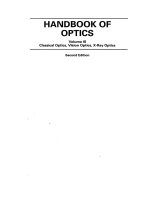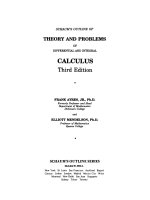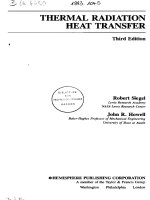- Trang chủ >>
- Khoa Học Tự Nhiên >>
- Vật lý
Boyd nonlinear optics, third edition (2)
Bạn đang xem bản rút gọn của tài liệu. Xem và tải ngay bản đầy đủ của tài liệu tại đây (4.71 MB, 620 trang )
www.pdfgrip.com
for my family
www.pdfgrip.com
Contents
Preface to the Third Edition
Preface to the Second Edition
Preface to the First Edition
1. The Nonlinear Optical Susceptibility
1.1.
1.2.
1.3.
1.4.
Introduction to Nonlinear Optics
Descriptions of Nonlinear Optical Processes
Formal Definition of the Nonlinear Susceptibility
Nonlinear Susceptibility of a Classical Anharmonic
Oscillator
1.5. Properties of the Nonlinear Susceptibility
1.6. Time-Domain Description of Optical Nonlinearities
1.7. Kramers–Kronig Relations in Linear and Nonlinear Optics
Problems
References
2. Wave-Equation Description of Nonlinear Optical Interactions
2.1. The Wave Equation for Nonlinear Optical Media
2.2. The Coupled-Wave Equations for Sum-Frequency
Generation
2.3. Phase Matching
2.4. Quasi-Phase-Matching
2.5. The Manley–Rowe Relations
2.6. Sum-Frequency Generation
2.7. Second-Harmonic Generation
xiii
xv
xvii
1
1
4
17
21
33
52
58
63
65
69
69
74
79
84
88
91
96
vii
www.pdfgrip.com
viii
3.
Contents
2.8. Difference-Frequency Generation and Parametric
Amplification
2.9. Optical Parametric Oscillators
2.10. Nonlinear Optical Interactions with Focused
Gaussian Beams
2.11. Nonlinear Optics at an Interface
Problems
References
116
122
128
132
Quantum-Mechanical Theory of the Nonlinear Optical
Susceptibility
135
3.1.
3.2.
3.3.
3.4.
3.5.
3.6.
3.7.
3.8.
3.9.
4.
5.
Introduction
Schrödinger Calculation of Nonlinear Optical Susceptibility
Density Matrix Formulation of Quantum Mechanics
Perturbation Solution of the Density Matrix
Equation of Motion
Density Matrix Calculation of the Linear Susceptibility
Density Matrix Calculation of the Second-Order
Susceptibility
Density Matrix Calculation of the Third-Order Susceptibility
Electromagnetically Induced Transparency
Local-Field Corrections to the Nonlinear
Optical Susceptibility
Problems
References
105
108
135
137
150
158
161
170
180
185
194
201
204
The Intensity-Dependent Refractive Index
207
4.1.
4.2.
4.3.
4.4.
4.5.
4.6.
4.7.
207
211
221
228
235
240
247
251
Descriptions of the Intensity-Dependent Refractive Index
Tensor Nature of the Third-Order Susceptibility
Nonresonant Electronic Nonlinearities
Nonlinearities Due to Molecular Orientation
Thermal Nonlinear Optical Effects
Semiconductor Nonlinearities
Concluding Remarks
References
Molecular Origin of the Nonlinear Optical Response
253
5.1. Nonlinear Susceptibilities Calculated Using
Time-Independent Perturbation Theory
253
www.pdfgrip.com
Contents
5.2. Semiempirical Models of the Nonlinear
Optical Susceptibility
Model of Boling, Glass, and Owyoung
5.3. Nonlinear Optical Properties of Conjugated Polymers
5.4. Bond-Charge Model of Nonlinear Optical Properties
5.5. Nonlinear Optics of Chiral Media
5.6. Nonlinear Optics of Liquid Crystals
Problems
References
6. Nonlinear Optics in the Two-Level Approximation
6.1. Introduction
6.2. Density Matrix Equations of Motion for a
Two-Level Atom
6.3. Steady-State Response of a Two-Level Atom to a
Monochromatic Field
6.4. Optical Bloch Equations
6.5. Rabi Oscillations and Dressed Atomic States
6.6. Optical Wave Mixing in Two-Level Systems
Problems
References
7. Processes Resulting from the Intensity-Dependent Refractive
Index
7.1.
7.2.
7.3.
7.4.
7.5.
Self-Focusing of Light and Other Self-Action Effects
Optical Phase Conjugation
Optical Bistability and Optical Switching
Two-Beam Coupling
Pulse Propagation and Temporal Solitons
Problems
References
8. Spontaneous Light Scattering and Acoustooptics
8.1. Features of Spontaneous Light Scattering
8.2. Microscopic Theory of Light Scattering
8.3. Thermodynamic Theory of Scalar Light Scattering
www.pdfgrip.com
ix
259
260
262
264
268
271
273
274
277
277
278
285
293
301
313
326
327
329
329
342
359
369
375
383
388
391
391
396
402
x
9.
Contents
8.4. Acoustooptics
Problems
References
413
427
428
Stimulated Brillouin and Stimulated Rayleigh Scattering
429
9.1.
9.2.
9.3.
9.4.
9.5.
9.6.
429
431
436
448
453
455
468
470
Stimulated Scattering Processes
Electrostriction
Stimulated Brillouin Scattering (Induced by Electrostriction)
Phase Conjugation by Stimulated Brillouin Scattering
Stimulated Brillouin Scattering in Gases
Stimulated Brillouin and Stimulated Rayleigh Scattering
Problems
References
10. Stimulated Raman Scattering and Stimulated Rayleigh-Wing
Scattering
10.1. The Spontaneous Raman Effect
10.2. Spontaneous versus Stimulated Raman Scattering
10.3. Stimulated Raman Scattering Described by the
Nonlinear Polarization
10.4. Stokes–Anti-Stokes Coupling in Stimulated
Raman Scattering
10.5. Coherent Anti-Stokes Raman Scattering
10.6. Stimulated Rayleigh-Wing Scattering
Problems
References
11. The Electrooptic and Photorefractive Effects
11.1.
11.2.
11.3.
11.4.
11.5.
11.6.
11.7.
Introduction to the Electrooptic Effect
Linear Electrooptic Effect
Electrooptic Modulators
Introduction to the Photorefractive Effect
Photorefractive Equations of Kukhtarev et al.
Two-Beam Coupling in Photorefractive Materials
Four-Wave Mixing in Photorefractive Materials
Problems
References
www.pdfgrip.com
473
473
474
479
488
499
501
508
508
511
511
512
516
523
526
528
536
540
540
Contents
12. Optically Induced Damage and Multiphoton Absorption
12.1.
12.2.
12.3.
12.4.
12.5.
Introduction to Optical Damage
Avalanche-Breakdown Model
Influence of Laser Pulse Duration
Direct Photoionization
Multiphoton Absorption and Multiphoton Ionization
Problems
References
13. Ultrafast and Intense-Field Nonlinear Optics
13.1. Introduction
13.2. Ultrashort Pulse Propagation Equation
13.3. Interpretation of the Ultrashort-Pulse
Propagation Equation
13.4. Intense-Field Nonlinear Optics
13.5. Motion of a Free Electron in a Laser Field
13.6. High-Harmonic Generation
13.7. Nonlinear Optics of Plasmas and Relativistic
Nonlinear Optics
13.8. Nonlinear Quantum Electrodynamics
Problem
References
xi
543
543
544
546
548
549
559
559
561
561
561
567
571
572
575
579
583
586
586
Appendices
589
A.
589
596
596
600
600
602
603
B.
C.
D.
E.
The SI System of Units
Further reading
The Gaussian System of Units
Further reading
Systems of Units in Nonlinear Optics
Relationship between Intensity and Field Strength
Physical Constants
Index
605
www.pdfgrip.com
Preface to the Third Edition
It has been a great pleasure for me to have prepared the latest edition of my
book on nonlinear optics. My intrigue in the subject matter of this book is as
strong as it was when the first edition was published in 1992.
The principal changes present in the third edition are as follows: (1) The
book has been entirely rewritten using the SI system of units. I personally
prefer the elegance of the gaussian system of units, which was used in the first
two editions, but I realize that most readers would prefer the SI system, and
the change was made for this reason. (2) In addition, a large number of minor
changes have been made throughout the text to clarify the intended meaning
and to make the arguments easier to follow. I am indebted to the countless
comments received from students and colleagues both in Rochester and from
around the world that have allowed me to improve the writing in this manner. (3) Moreover, several sections that treat entirely new material have been
added. Applications of harmonic generation, including applications within the
fields of microscopy and biophotonics, are treated in Subsection 2.7.1. Electromagnetically induced transparency is treated in Section 3.8. Some brief but
crucial comments regarding limitations to the maximum size of the intensityinduced refractive-index change are made in Section 4.7. The use of nonlinear
optical methods for inducing unusual values of the group velocity of light are
discussed briefly in Section 3.8 and in Subsection 6.6.2. Spectroscopy based
on coherent anti–Stokes Raman scattering (CARS) is discussed in Section
10.5. In addition, the appendix has been expanded to include brief descriptions of both the SI and gaussian systems of units and procedures for conversion between them.
xiii
www.pdfgrip.com
xiv
Preface to the Third Edition
The book in its present form contains far too much material to be covered
within a conventional one-semester course. For this reason, I am often asked
for advice on how to structure a course based on the content of my textbook.
Some of my thoughts along these lines are as follows: (1) I have endeavored
as much as possible to make each part of the book self-contained. Thus, the
sophisticated reader can read the book in any desired order and can read only
sections of personal interest. (2) Nonetheless, when using the book as a course
text, I suggest starting with Chapters 1 and 2, which present the basic formalism of the subject material. At that point, topics of interest can be taught in
nearly any order. (3) Special mention should be made regarding Chapters 3
and 6, which deal with quantum mechanical treatments of nonlinear optical
phenomena. These chapters are among the most challenging of any within the
book. These chapters can be skipped entirely if one is comfortable with establishing only a phenomenological description of nonlinear optical phenomena.
Alternatively, these chapters can form the basis of a formal treatment of how
the laws of quantum mechanics can be applied to provide detailed descriptions of a variety of optical phenomena. (4) From a different perspective, I am
sometimes asked for my advice on extracting the essential material from the
book—that is, in determining which are topics that everyone should know.
This question often arises in the context of determining what material students should study when preparing for qualifying exams. My best response to
questions of this sort is that the essential material is as follows: Chapter 1 in
its entirety; Sections 2.1–2.3, 2.4, and 2.10 of Chapter 2; Subsection 3.5.1 of
Chapter 3; Sections 4.1, 4.6, and 4.7 of Chapter 4; Chapter 7 in its entirety;
Section 8.1 of Chapter 8; and Section 9.1 of Chapter 9. (5) Finally, I often tell
my classroom students that my course is in some ways as much a course on
optical physics as it is a course on nonlinear optics. I simply use the concept
of nonlinear optics as a unifying theme for presenting conceptual issues and
practical applications of optical physics. Recognizing that this is part of my
perspective in writing, this book could be useful to its readers.
I want to express my thanks once again to the many students and colleagues
who have given me useful advice and comments regarding this book over the
past fifteen years. I am especially indebted to my own graduate students for
the assistance and encouragement they have given to me.
Robert Boyd
Rochester, New York
October, 2007
www.pdfgrip.com
Preface to the Second Edition
In the ten years since the publication of the first edition of this book, the field
of nonlinear optics has continued to achieve new advances both in fundamental physics and in practical applications. Moreover, the author’s fascination
with this subject has held firm over this time interval. The present work extends the treatment of the first edition by including a considerable body of
additional material and by making numerous small improvements in the presentation of the material included in the first edition.
The primary differences between the first and second editions are as follows.
Two additional sections have been added to Chapter 1, which deals with the
nonlinear optical susceptibility. Section 1.6 deals with time-domain descriptions of optical nonlinearities, and Section 1.7 deals with Kramers–Kronig
relations in nonlinear optics. In addition, a description of the symmetry properties of gallium arsenide has been added to Section 1.5.
Three sections have been added to Chapter 2, which treats wave-equation
descriptions of nonlinear optical interactions. Section 2.8 treats optical parametric oscillators, Section 2.9 treats quasi-phase-matching, and Section 2.11
treats nonlinear optical surface interactions.
Two sections have been added to Chapter 4, which deals with the intensitydependent refractive index. Section 4.5 treats thermal nonlinearities, and Section 4.6 treats semiconductor nonlinearities.
Chapter 5 is an entirely new chapter dealing with the molecular origin of
the nonlinear optical response. (Consequently the chapter numbers of all the
following chapters are one greater than those of the first edition.) This chapter treats electronic nonlinearities in the static approximation, semiempirical
xv
www.pdfgrip.com
xvi
Preface to the Second Edition
models of the nonlinear susceptibility, the nonlinear response of conjugated
polymers, the bond charge model of optical nonlinearities, nonlinear optics of
chiral materials, and nonlinear optics of liquid crystals.
In Chapter 7 on processes resulting from the intensity-dependent refractive index, the section on self-action effects (now Section 7.1) has been significantly expanded. In addition, a description of optical switching has been
included in Section 7.3, now entitled optical bistability and optical switching.
In Chapter 9, which deals with stimulated Brillouin scattering, a discussion
of transient effects has been included.
Chapter 12 is an entirely new chapter dealing with optical damage and multiphoton absorption. Chapter 13 is an entirely new chapter dealing with ultrafast and intense-field nonlinear optics.
The Appendices have been expanded to include a treatment of the gaussian
system of units. In addition, many additional homework problems and literature references have been added.
I would like to take this opportunity to thank my many colleagues who
have given me advice and suggestions regarding the writing of this book. In
addition to the individuals mentioned in the preface to the first edition, I would
like to thank G. S. Agarwal, P. Agostini, G. P. Agrawal, M. D. Feit, A. L.
Gaeta, D. J. Gauthier, L. V. Hau, F. Kajzar, M. Kauranen, S. G. Lukishova,
A. C. Melissinos, Q-H. Park, M. Saffman, B. W. Shore, D. D. Smith, I. A.
Walmsley, G. W. Wicks, and Z. Zyss. I especially wish to thank M. Kauranen
and A. L. Gaeta for suggesting additional homework problems and to thank
A. L. Gaeta for advice on the preparation of Section 13.2.
www.pdfgrip.com
Preface to the First Edition
Nonlinear optics is the study of the interaction of intense laser light with matter. This book is a textbook on nonlinear optics at the level of a beginning
graduate student. The intent of the book is to provide an introduction to the
field of nonlinear optics that stresses fundamental concepts and that enables
the student to go on to perform independent research in this field. The author has successfully used a preliminary version of this book in his course at
the University of Rochester, which is typically attended by students ranging
from seniors to advanced PhD students from disciplines that include optics,
physics, chemistry, electrical engineering, mechanical engineering, and chemical engineering. This book could be used in graduate courses in the areas of
nonlinear optics, quantum optics, quantum electronics, laser physics, electrooptics, and modern optics. By deleting some of the more difficult sections,
this book would also be suitable for use by advanced undergraduates. On the
other hand, some of the material in the book is rather advanced and would be
suitable for senior graduate students and research scientists.
The field of nonlinear optics is now thirty years old, if we take its beginnings to be the observation of second-harmonic generation by Franken and
coworkers in 1961. Interest in this field has grown continuously since its beginnings, and the field of nonlinear optics now ranges from fundamental studies of the interaction of light with matter to applications such as laser frequency conversion and optical switching. In fact, the field of nonlinear optics
has grown so enormously that it is not possible for one book to cover all of the
topics of current interest. In addition, since I want this book to be accessible to
beginning graduate students, I have attempted to treat the topics that are covered in a reasonably self-contained manner. This consideration also restricts
xvii
www.pdfgrip.com
xviii
Preface to the First Edition
the number of topics that can be treated. My strategy in deciding what topics
to include has been to stress the fundamental aspects of nonlinear optics, and
to include applications and experimental results only as necessary to illustrate
these fundamental issues. Many of the specific topics that I have chosen to
include are those of particular historical value.
Nonlinear optics is notationally very complicated, and unfortunately much
of the notational complication is unavoidable. Because the notational aspects
of nonlinear optics have historically been very confusing, considerable effort
is made, especially in the early chapters, to explain the notational conventions.
The book uses primarily the gaussian system of units, both to establish a connection with the historical papers of nonlinear optics, most of which were
written using the gaussian system, and also because the author believes that
the laws of electromagnetism are more physically transparent when written in
this system. At several places in the text (see especially the appendices at the
end of the book), tables are provided to facilitate conversion to other systems
of units.
The book is organized as follows: Chapter 1 presents an introduction to the
field of nonlinear optics from the perspective of the nonlinear susceptibility.
The nonlinear susceptibility is a quantity that is used to determine the nonlinear polarization of a material medium in terms of the strength of an applied
optical-frequency electric field. It thus provides a framework for describing
nonlinear optical phenomena. Chapter 2 continues the description of nonlinear optics by describing the propagation of light waves through nonlinear optical media by means of the optical wave equation. This chapter introduces the
important concept of phase matching and presents detailed descriptions of the
important nonlinear optical phenomena of second-harmonic generation and
sum- and difference-frequency generation. Chapter 3 concludes the introductory portion of the book by presenting a description of the quantum mechanical theory of the nonlinear optical susceptibility. Simplified expressions for
the nonlinear susceptibility are first derived through use of the Schrödinger
equation, and then more accurate expressions are derived through use of the
density matrix equations of motion. The density matrix formalism is itself developed in considerable detail in this chapter in order to render this important
discussion accessible to the beginning student.
Chapters 4 through 6 deal with properties and applications of the nonlinear
refractive index. Chapter 4 introduces the topic of the nonlinear refractive index. Properties, including tensor properties, of the nonlinear refractive index
are discussed in detail, and physical processes that lead to the nonlinear refractive index, such as nonresonant electronic polarization and molecular orientation, are described. Chapter 5 is devoted to a description of nonlinearities
www.pdfgrip.com
Preface to the First Edition
xix
in the refractive index resulting from the response of two-level atoms. Related
topics that are discussed in this chapter include saturation, power broadening, optical Stark shifts, Rabi oscillations, and dressed atomic states. Chapter
6 deals with applications of the nonlinear refractive index. Topics that are
included are optical phase conjugation, self focusing, optical bistability, twobeam coupling, pulse propagation, and the formation of optical solitons.
Chapters 7 through 9 deal with spontaneous and stimulated light scattering and the related topic of acoustooptics. Chapter 7 introduces this area by
presenting a description of theories of spontaneous light scattering and by describing the important practical topic of acoustooptics. Chapter 8 presents a
description of stimulated Brillouin and stimulated Rayleigh scattering. These
topics are related in that they both entail the scattering of light from material
disturbances that can be described in terms of the standard thermodynamic
variables of pressure and entropy. Also included in this chapter is a description of phase conjugation by stimulated Brillouin scattering and a theoretical description of stimulated Brillouin scattering in gases. Chapter 9 presents
a description of stimulated Raman and stimulated Rayleigh-wing scattering.
These processes are related in that they entail the scattering of light from disturbances associated with the positions of atoms within a molecule.
The book concludes with Chapter 10, which treats the electrooptic and photorefractive effects. The chapter begins with a description of the electrooptic
effect and describes how this effect can be used to fabricate light modulators.
The chapter then presents a description of the photorefractive effect, which is
a nonlinear optical interaction that results from the electrooptic effect. The use
of the photorefractive effect in two-beam coupling and in four-wave mixing
is also described.
The author wishes to acknowledge his deep appreciation for discussions
of the material in this book with his graduate students at the University of
Rochester. He is sure that he has learned as much from them as they have
from him. He also gratefully acknowledges discussions with numerous other
professional colleagues, including N. Bloembergen, D. Chemla, R. Y. Chiao,
J. H. Eberly, C. Flytzanis, J. Goldhar, G. Grynberg, J. H. Haus, R. W. Hellwarth, K. R. MacDonald, S. Mukamel, P. Narum, M. G. Raymer, J. E. Sipe,
C. R. Stroud, Jr., C. H. Townes, H. Winful, and B. Ya. Zel’dovich. In addition,
the assistance of J. J. Maki and A. Gamliel in the preparation of the figures is
gratefully acknowledged.
www.pdfgrip.com
Chapter 1
The Nonlinear Optical Susceptibility
1.1. Introduction to Nonlinear Optics
Nonlinear optics is the study of phenomena that occur as a consequence of
the modification of the optical properties of a material system by the presence of light. Typically, only laser light is sufficiently intense to modify the
optical properties of a material system. The beginning of the field of nonlinear optics is often taken to be the discovery of second-harmonic generation
by Franken et al. (1961), shortly after the demonstration of the first working
laser by Maiman in 1960.∗ Nonlinear optical phenomena are “nonlinear” in
the sense that they occur when the response of a material system to an applied optical field depends in a nonlinear manner on the strength of the optical
field. For example, second-harmonic generation occurs as a result of the part
of the atomic response that scales quadratically with the strength of the applied optical field. Consequently, the intensity of the light generated at the
second-harmonic frequency tends to increase as the square of the intensity of
the applied laser light.
In order to describe more precisely what we mean by an optical nonlinearity, let us consider how the dipole moment per unit volume, or polarization
˜
P˜ (t), of a material system depends on the strength E(t)
of an applied optical
∗ It should be noted, however, that some nonlinear effects were discovered prior to the advent of
the laser. The earliest example known to the authors is the observation of saturation effects in the
luminescence of dye molecules reported by G.N. Lewis et al. (1941).
1
www.pdfgrip.com
2
1 ♦ The Nonlinear Optical Susceptibility
field.∗ In the case of conventional (i.e., linear) optics, the induced polarization
depends linearly on the electric field strength in a manner that can often be
described by the relationship
P˜ (t) =
0χ
(1)
˜
E(t),
(1.1.1)
where the constant of proportionality χ (1) is known as the linear susceptibility and 0 is the permittivity of free space. In nonlinear optics, the optical
response can often be described by generalizing Eq. (1.1.1) by expressing the
˜
polarization P˜ (t) as a power series in the field strength E(t)
as
P˜ (t) =
0
˜ + χ (2) E˜ 2 (t) + χ (3) E˜ 3 (t) + · · ·
χ (1) E(t)
≡ P˜ (1) (t) + P˜ (2) (t) + P˜ (3) (t) + · · · .
(1.1.2)
The quantities χ (2) and χ (3) are known as the second- and third-order nonlinear optical susceptibilities, respectively. For simplicity, we have taken the
˜ to be scalar quantities in writing Eqs. (1.1.1) and (1.1.2).
fields P˜ (t) and E(t)
In Section 1.3 we show how to treat the vector nature of the fields; in such
a case χ (1) becomes a second-rank tensor, χ (2) becomes a third-rank tensor,
and so on. In writing Eqs. (1.1.1) and (1.1.2) in the forms shown, we have
also assumed that the polarization at time t depends only on the instantaneous
value of the electric field strength. The assumption that the medium responds
instantaneously also implies (through the Kramers–Kronig relations† ) that the
medium must be lossless and dispersionless. We shall see in Section 1.3 how
to generalize these equations for the case of a medium with dispersion and
loss. In general, the nonlinear susceptibilities depend on the frequencies of the
applied fields, but under our present assumption of instantaneous response, we
take them to be constants.
We shall refer to P˜ (2) (t) = 0 χ (2) E˜ 2 (t) as the second-order nonlinear polarization and to P˜ (3) (t) = 0 χ (3) E˜ 3 (t) as the third-order nonlinear polarization. We shall see later in this section that physical processes that occur as
a result of the second-order polarization P˜ (2) tend to be distinct from those
that occur as a result of the third-order polarization P˜ (3) . In addition, we shall
show in Section 1.5 that second-order nonlinear optical interactions can occur
only in noncentrosymmetric crystals—that is, in crystals that do not display
inversion symmetry. Since liquids, gases, amorphous solids (such as glass),
∗ Throughout the text, we use the tilde ( ) to denote a quantity that varies rapidly in time. Constant
˜
quantities, slowly varying quantities, and Fourier amplitudes are written without the tilde. See, for
example, Eq. (1.2.1).
† See, for example, Loudon (1973, Chapter 4) or the discussion in Section 1.7 of this book for a
discussion of the Kramers–Kronig relations.
www.pdfgrip.com
1.1. Introduction to Nonlinear Optics
3
and even many crystals display inversion symmetry, χ (2) vanishes identically
for such media, and consequently such materials cannot produce second-order
nonlinear optical interactions. On the other hand, third-order nonlinear optical
interactions (i.e., those described by a χ (3) susceptibility) can occur for both
centrosymmetric and noncentrosymmetric media.
We shall see in later sections of this book how to calculate the values of the
nonlinear susceptibilities for various physical mechanisms that lead to optical
nonlinearities. For the present, we shall make a simple order-of-magnitude
estimate of the size of these quantities for the common case in which the nonlinearity is electronic in origin (see, for instance, Armstrong et al., 1962). One
might expect that the lowest-order correction term P˜ (2) would be comparable to the linear response P˜ (1) when the amplitude of the applied field E˜ is of
the order of the characteristic atomic electric field strength Eat = e/(4π 0 a 02 ),
where −e is the charge of the electron and a0 = 4π 0 h¯ 2 /me2 is the Bohr radius of the hydrogen atom (here h¯ is Planck’s constant divided by 2π , and m is
the mass of the electron). Numerically, we find that Eat = 5.14 × 1011 V/m.∗
We thus expect that under conditions of nonresonant excitation the secondorder susceptibility χ (2) will be of the order of χ (1) /Eat . For condensed matter χ (1) is of the order of unity, and we hence expect that χ (2) will be of the
order of 1/Eat , or that
χ (2)
1.94 × 10−12 m/V.
(1.1.3)
Similarly, we expect χ (3) to be of the order of χ (1) /Eat2 , which for condensed
matter is of the order of
χ (3)
3.78 × 10−24 m2 /V2 .
(1.1.4)
These predictions are in fact quite accurate, as one can see by comparing these
values with actual measured values of χ (2) (see, for instance, Table 1.5.3) and
χ (3) (see, for instance, Table 4.3.1).
For certain purposes, it is useful to express the second- and third-order
susceptibilities in terms of fundamental physical constants. As just noted,
for condensed matter χ (1) is of the order of unity. This result can be justified either as an empirical fact or can be justified more rigorously by noting
that χ (1) is the product of atomic number density and atomic polarizability.
The number density N of condensed matter is of the order of (a0 )−3 , and
the nonresonant polarizability is of the order of (a0 )3 . We thus deduce that
χ (1) is of the order of unity. We then find that χ (2) (4π 0 )3 h¯ 4 /m2 e5 and
χ (3) (4π 0 )6 h¯ 8 /m4 e10 . See Boyd (1999) for further details.
∗ Except where otherwise noted, we use the SI (MKS) system of units throughout this book. The
appendix to this book presents a prescription for converting among systems of units.
www.pdfgrip.com
1 ♦ The Nonlinear Optical Susceptibility
4
The most usual procedure for describing nonlinear optical phenomena is
based on expressing the polarization P˜ (t) in terms of the applied electric field
˜
strength E(t),
as we have done in Eq. (1.1.2). The reason why the polarization
plays a key role in the description of nonlinear optical phenomena is that a
time-varying polarization can act as the source of new components of the
electromagnetic field. For example, we shall see in Section 2.1 that the wave
equation in nonlinear optical media often has the form
n2 ∂ 2 E˜
1 ∂ 2 P˜ NL
,
∇ 2 E˜ − 2 2 =
2 ∂t 2
c ∂t
0c
(1.1.5)
where n is the usual linear refractive index and c is the speed of light in vacuum. We can interpret this expression as an inhomogeneous wave equation
in which the polarization P˜ NL associated with the nonlinear response drives
˜ Since ∂ 2 P˜ NL /∂t 2 is a measure of the acceleration of the
the electric field E.
charges that constitute the medium, this equation is consistent with Larmor’s
theorem of electromagnetism which states that accelerated charges generate
electromagnetic radiation.
It should be noted that the power series expansion expressed by Eq. (1.1.2)
need not necessarily converge. In such circumstances the relationship between
the material response and the applied electric field amplitude must be expressed using different procedures. One such circumstance is that of resonant
excitation of an atomic system, in which case an appreciable fraction of the
atoms can be removed from the ground state. Saturation effects of this sort
can be described by procedures developed in Chapter 6. Even under nonresonant conditions, Eq. (1.1.2) loses its validity if the applied laser field strength
becomes comparable to the characteristic atomic field strength Eat , because
of strong photoionization that can occur under these conditions. For future
reference, we note that the laser intensity associated with a peak field strength
of Eat is given by
1
2
20
2
16
2
(1.1.6)
0 cEat = 3.5 × 10 W/m = 3.5 × 10 W/cm .
2
We shall see later in this book (see especially Chapter 13) how nonlinear
optical processes display qualitatively distinct features when excited by such
super-intense fields.
Iat =
1.2. Descriptions of Nonlinear Optical Processes
In the present section, we present brief qualitative descriptions of a number
of nonlinear optical processes. In addition, for those processes that can oc-
www.pdfgrip.com
1.2. Descriptions of Nonlinear Optical Processes
5
F IGURE 1.2.1 (a) Geometry of second-harmonic generation. (b) Energy-level diagram describing second-harmonic generation.
cur in a lossless medium, we indicate how they can be described in terms of
the nonlinear contributions to the polarization described by Eq. (1.1.2).∗ Our
motivation is to provide an indication of the variety of nonlinear optical phenomena that can occur. These interactions are described in greater detail in
later sections of this book. In this section we also introduce some notational
conventions and some of the basic concepts of nonlinear optics.
1.2.1. Second-Harmonic Generation
As an example of a nonlinear optical interaction, let us consider the process of
second-harmonic generation, which is illustrated schematically in Fig. 1.2.1.
Here a laser beam whose electric field strength is represented as
˜ = Ee−iωt + c.c.
E(t)
(1.2.1)
is incident upon a crystal for which the second-order susceptibility χ (2) is
nonzero. The nonlinear polarization that is created in such a crystal is given
according to Eq. (1.1.2) as P˜ (2) (t) = 0 χ (2) E˜ 2 (t) or explicitly as
P˜ (2) (t) = 2 0 χ (2) EE ∗ +
0χ
(2)
E 2 e−i2ωt + c.c. .
(1.2.2)
We see that the second-order polarization consists of a contribution at zero frequency (the first term) and a contribution at frequency 2ω (the second term).
According to the driven wave equation (1.1.5), this latter contribution can
lead to the generation of radiation at the second-harmonic frequency. Note
that the first contribution in Eq. (1.2.2) does not lead to the generation of electromagnetic radiation (because its second time derivative vanishes); it leads
to a process known as optical rectification, in which a static electric field is
created across the nonlinear crystal.
∗ Recall that Eq. (1.1.2) is valid only for a medium that is lossless and dispersionless.
www.pdfgrip.com
1 ♦ The Nonlinear Optical Susceptibility
6
Under proper experimental conditions, the process of second-harmonic
generation can be so efficient that nearly all of the power in the incident
beam at frequency ω is converted to radiation at the second-harmonic frequency 2ω. One common use of second-harmonic generation is to convert the
output of a fixed-frequency laser to a different spectral region. For example,
the Nd:YAG laser operates in the near infrared at a wavelength of 1.06 μm.
Second-harmonic generation is routinely used to convert the wavelength of
the radiation to 0.53 μm, in the middle of the visible spectrum.
Second-harmonic generation can be visualized by considering the interaction in terms of the exchange of photons between the various frequency components of the field. According to this picture, which is illustrated in part (b)
of Fig. 1.2.1, two photons of frequency ω are destroyed, and a photon of frequency 2ω is simultaneously created in a single quantum-mechanical process.
The solid line in the figure represents the atomic ground state, and the dashed
lines represent what are known as virtual levels. These levels are not energy
eigenlevels of the free atom but rather represent the combined energy of one of
the energy eigenstates of the atom and of one or more photons of the radiation
field.
The theory of second-harmonic generation is developed more fully in Section 2.6.
1.2.2. Sum- and Difference-Frequency Generation
Let us next consider the circumstance in which the optical field incident upon
a second-order nonlinear optical medium consists of two distinct frequency
components, which we represent in the form
˜ = E1 e−iω1 t + E2 e−iω2 t + c.c.
E(t)
(1.2.3)
Then, assuming as in Eq. (1.1.2) that the second-order contribution to the
nonlinear polarization is of the form
P˜ (2) (t) =
0χ
(2)
˜ 2,
E(t)
(1.2.4)
we find that the nonlinear polarization is given by
P˜ (2) (t) =
0χ
(2)
E12 e−2iω1 t + E22 e−2iω2 t + 2E1 E2 e−i(ω1 +ω2 )t
+ 2E1 E2∗ e−i(ω1 −ω2 )t + c.c. + 2 0 χ (2) E1 E1∗ + E2 E2∗ .
(1.2.5)
www.pdfgrip.com
1.2. Descriptions of Nonlinear Optical Processes
7
It is convenient to express this result using the notation
P˜ (2) (t) =
P (ωn )e−iωn t ,
(1.2.6)
n
where the summation extends over positive and negative frequencies ωn . The
complex amplitudes of the various frequency components of the nonlinear
polarization are hence given by
P (2ω1 ) = 0 χ (2) E12 (SHG),
P (2ω2 ) =
0χ
(2)
E22
(SHG),
P (ω1 + ω2 ) = 2 0 χ (2) E1 E2
P (ω1 − ω2 ) = 2
P (0) = 2
∗
0 χ E1 E2
(2)
∗
0 χ (E1 E1
(SFG),
(2)
(1.2.7)
(DFG),
+ E2 E2∗ )
(OR).
Here we have labeled each expression by the name of the physical process
that it describes, such as second-harmonic generation (SHG), sum-frequency
generation (SFG), difference-frequency generation (DFG), and optical rectification (OR). Note that, in accordance with our complex notation, there is also
a response at the negative of each of the nonzero frequencies just given:
P (−2ω1 ) =
0χ
(2)
E1∗ 2 ,
P (−ω1 − ω2 ) = 2 0 χ (2) E1∗ E2∗ ,
P (−2ω2 ) =
0χ
(2)
E2∗ 2 ,
P (ω2 − ω1 ) = 2 0 χ (2) E2 E1∗ .
(1.2.8)
However, since each of these quantities is simply the complex conjugate of
one of the quantities given in Eq. (1.2.7), it is not necessary to take explicit
account of both the positive and negative frequency components.∗
∗ Not all workers in nonlinear optics use our convention that the fields and polarizations are given
by Eqs. (1.2.3) and (1.2.6). Another common convention is to define the field amplitudes according to
1
˜
E e−iω1 t + E2 e−iω2 t + c.c. ,
E(t)
=
2 1
1
P˜ (t) =
P (ωn )eiωn t ,
2 n
where in the second expression the summation extends over all positive and negative frequencies.
Using this convention, one finds that
1
1
(2) 2
P (2ω1 ) =
P (2ω2 ) = 0 χ (2) E22 ,
0 χ E1 ,
2
2
P (ω1 + ω2 ) = 0 χ (2) E1 E2 ,
P (ω1 − ω2 ) = 0 χ (2) E1 E2∗ ,
P (0) = 0 χ (2) E1 E1∗ + E2 E2∗ .
Note that these expressions differ from Eqs. (1.2.7) by factors of 12 .
www.pdfgrip.com
8
1 ♦ The Nonlinear Optical Susceptibility
We see from Eq. (1.2.7) that four different nonzero frequency components
are present in the nonlinear polarization. However, typically no more than one
of these frequency components will be present with any appreciable intensity
in the radiation generated by the nonlinear optical interaction. The reason for
this behavior is that the nonlinear polarization can efficiently produce an output signal only if a certain phase-matching condition (which is discussed in
detail in Section 2.7) is satisfied, and usually this condition cannot be satisfied
for more than one frequency component of the nonlinear polarization. Operationally, one often chooses which frequency component will be radiated by
properly selecting the polarization of the input radiation and the orientation
of the nonlinear crystal.
1.2.3. Sum-Frequency Generation
Let us now consider the process of sum-frequency generation, which is illustrated in Fig. 1.2.2. According to Eq. (1.2.7), the complex amplitude of the
nonlinear polarization describing this process is given by the expression
P (ω1 + ω2 ) = 2 0 χ (2) E1 E2 .
(1.2.9)
In many ways the process of sum-frequency generation is analogous to that of
second-harmonic generation, except that in sum-frequency generation the two
input waves are at different frequencies. One application of sum-frequency
generation is to produce tunable radiation in the ultraviolet spectral region by
choosing one of the input waves to be the output of a fixed-frequency visible
laser and the other to be the output of a frequency-tunable visible laser. The
theory of sum-frequency generation is developed more fully in Sections 2.2
and 2.4.
F IGURE 1.2.2 Sum-frequency generation. (a) Geometry of the interaction.
(b) Energy-level description.
www.pdfgrip.com
1.2. Descriptions of Nonlinear Optical Processes
9
1.2.4. Difference-Frequency Generation
The process of difference-frequency generation is described by a nonlinear
polarization of the form
P (ω1 − ω2 ) = 2 0 χ (2) E1 E2∗
(1.2.10)
and is illustrated in Fig. 1.2.3. Here the frequency of the generated wave is
the difference of those of the applied fields. Difference-frequency generation
can be used to produce tunable infrared radiation by mixing the output of a
frequency-tunable visible laser with that of a fixed-frequency visible laser.
Superficially, difference-frequency generation and sum-frequency generation appear to be very similar processes. However, an important difference between the two processes can be deduced from the description of
difference-frequency generation in terms of a photon energy-level diagram
(part (b) of Fig. 1.2.3). We see that conservation of energy requires that
for every photon that is created at the difference frequency ω3 = ω1 − ω2 ,
a photon at the higher input frequency (ω1 ) must be destroyed and a photon at the lower input frequency (ω2 ) must be created. Thus, the lowerfrequency input field is amplified by the process of difference-frequency
generation. For this reason, the process of difference-frequency generation
is also known as optical parametric amplification. According to the photon
energy-level description of difference-frequency generation, the atom first
absorbs a photon of frequency ω1 and jumps to the highest virtual level.
This level decays by a two-photon emission process that is stimulated by
the presence of the ω2 field, which is already present. Two-photon emission
can occur even if the ω2 field is not applied. The generated fields in such
a case are very much weaker, since they are created by spontaneous twophoton emission from a virtual level. This process is known as parametric
F IGURE 1.2.3 Difference-frequency generation. (a) Geometry of the interaction.
(b) Energy-level description.
www.pdfgrip.com
10
1 ♦ The Nonlinear Optical Susceptibility
fluorescence and has been observed experimentally (Byer and Harris, 1968;
Harris et al., 1967).
The theory of difference-frequency generation is developed more fully in
Section 2.5.
1.2.5. Optical Parametric Oscillation
We have just seen that in the process of difference-frequency generation the
presence of radiation at frequency ω2 or ω3 can stimulate the emission of
additional photons at these frequencies. If the nonlinear crystal used in this
process is placed inside an optical resonator, as shown in Fig. 1.2.4, the ω2
and/or ω3 fields can build up to large values. Such a device is known as an optical parametric oscillator. Optical parametric oscillators are frequently used at
infrared wavelengths, where other sources of tunable radiation are not readily
available. Such a device is tunable because any frequency ω2 that is smaller
than ω1 can satisfy the condition ω2 + ω3 = ω1 for some frequency ω3 . In
practice, one controls the output frequency of an optical parametric oscillator
by adjusting the phase-matching condition, as discussed in Section 2.7. The
applied field frequency ω1 is often called the pump frequency, the desired output frequency is called the signal frequency, and the other, unwanted, output
frequency is called the idler frequency.
1.2.6. Third-Order Nonlinear Optical Processes
We next consider the third-order contribution to the nonlinear polarization
P˜ (3) (t) =
0χ
(3)
˜ 3.
E(t)
(1.2.11)
˜
For the general case in which the field E(t)
is made up of several different
frequency components, the expression for P˜ (3) (t) is very complicated. For
this reason, we first consider the simple case in which the applied field is
F IGURE 1.2.4 The optical parametric oscillator. The cavity end mirrors have high
reflectivities at frequencies ω2 and/or ω3 . The output frequencies can be tuned by
means of the orientation of the crystal.
www.pdfgrip.com
1.2. Descriptions of Nonlinear Optical Processes
11
monochromatic and is given by
˜ = E cos ωt.
E(t)
(1.2.12)
Then, through use of the identity cos3 ωt = 14 cos 3ωt + 34 cos ωt , we can express the nonlinear polarization as
1
3
(1.2.13)
P˜ (3) (t) = 0 χ (3) E 3 cos 3ωt + 0 χ (3) E 3 cos ωt.
4
4
The significance of each of the two terms in this expression is described briefly
below.
1.2.7. Third-Harmonic Generation
The first term in Eq. (1.2.13) describes a response at frequency 3ω that is
created by an applied field at frequency ω. This term leads to the process
of third-harmonic generation, which is illustrated in Fig. 1.2.5. According to
the photon description of this process, shown in part (b) of the figure, three
photons of frequency ω are destroyed and one photon of frequency 3ω is
created in the microscopic description of this process.
1.2.8. Intensity-Dependent Refractive Index
The second term in Eq. (1.2.13) describes a nonlinear contribution to the polarization at the frequency of the incident field; this term hence leads to a
nonlinear contribution to the refractive index experienced by a wave at frequency ω. We shall see in Section 4.1 that the refractive index in the presence
of this type of nonlinearity can be represented as
n = n0 + n2 I,
(1.2.14a)
F IGURE 1.2.5 Third-harmonic generation. (a) Geometry of the interaction.
(b) Energy-level description.
www.pdfgrip.com









